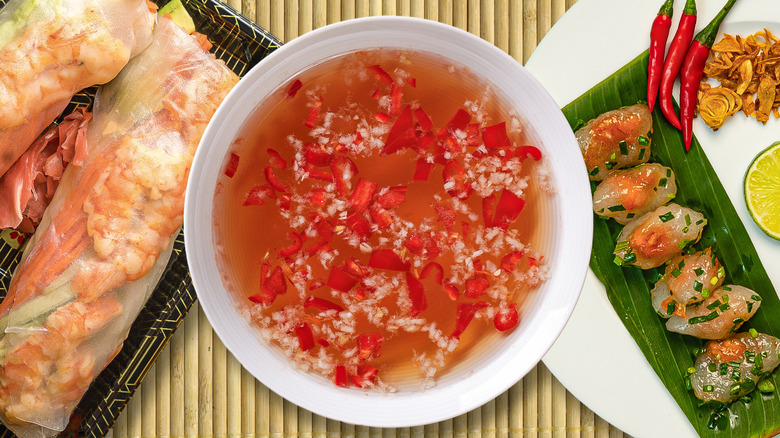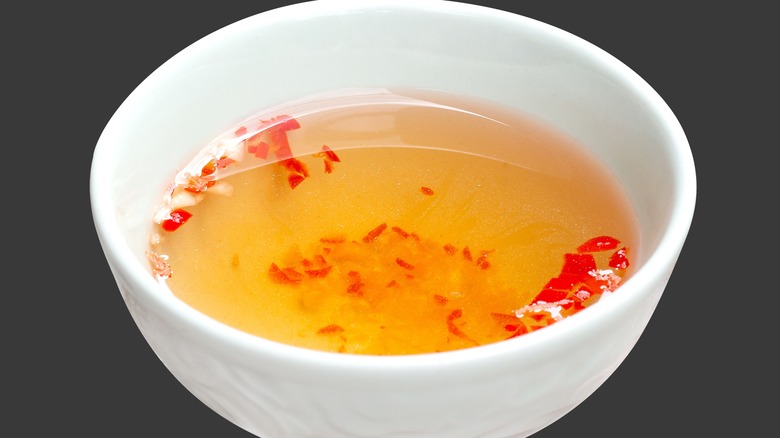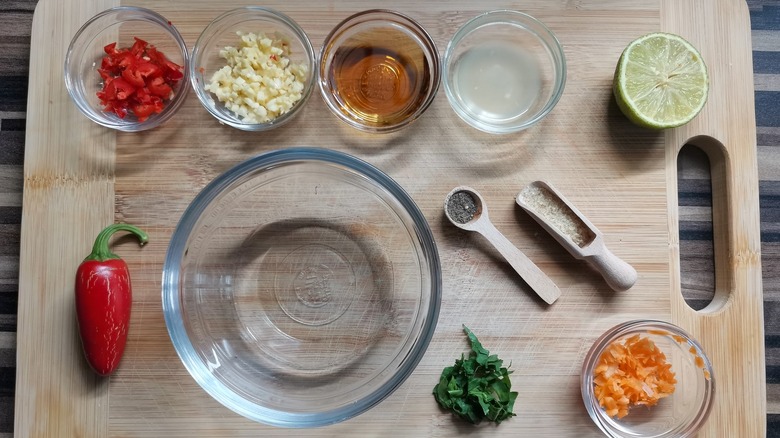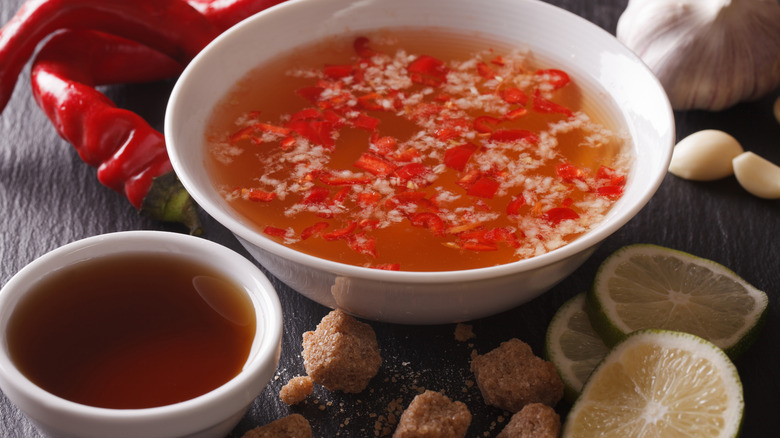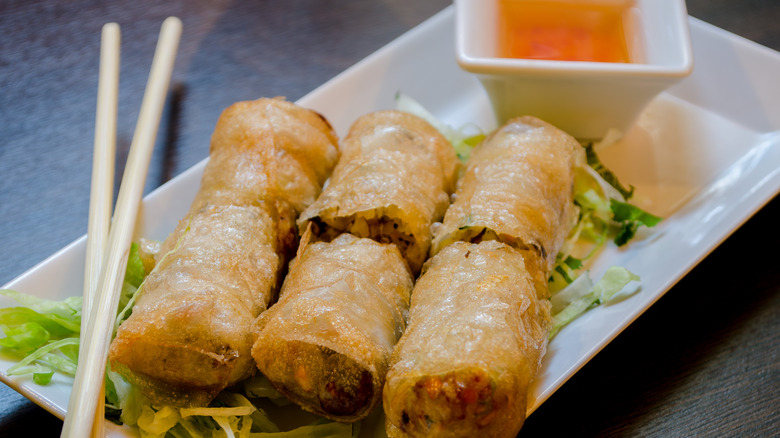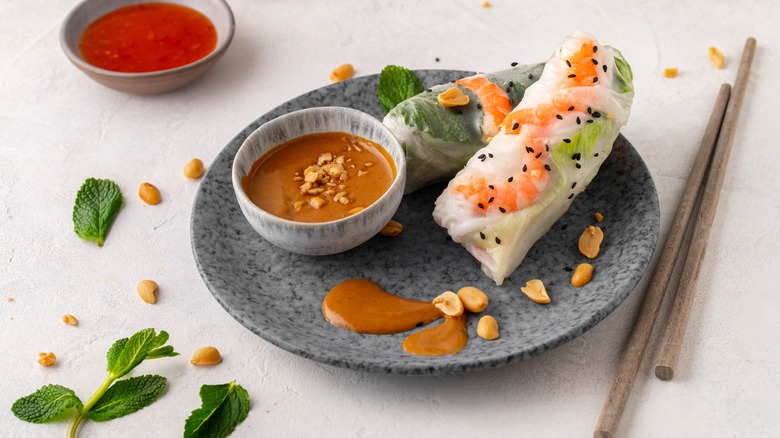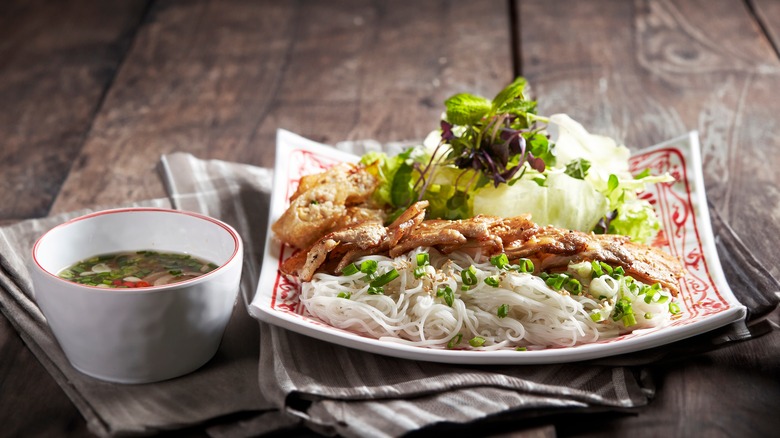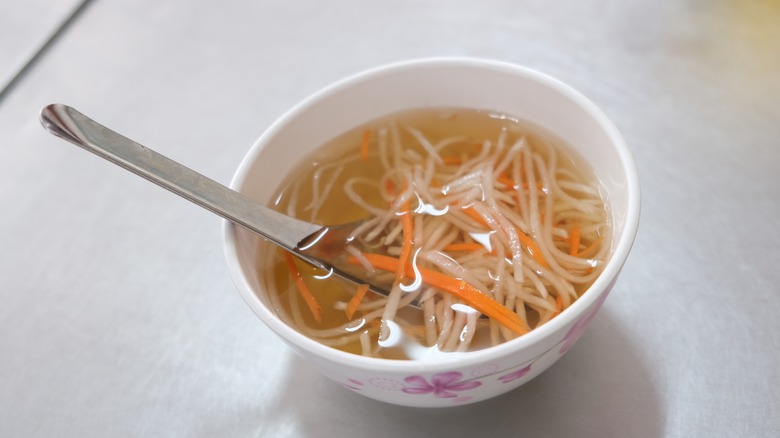Nước Chấm Is The Fish Sauce You Should Always Have In Your Pantry
When it comes to condiments, nước chấm has very little competition. Few sauces can match the simultaneous versatility and depth of flavor offered by this traditional and beloved Vietnamese fish sauce-based dip. Made from a blend of just a few simple but nonetheless bold and tasty, ingredients nước chấm is somewhat of an indispensable culinary staple, enhancing virtually any dish that it is paired with, from crunchy spring rolls to sizzling rice and noodle dishes. Indeed, one of nước chấm's greatest assets is its versatility. Its unique combination of flavors, light and refreshing consistency, and ease of adaptability make it suitable for combining with an array of other ingredients, appetizers, and meals, solidifying it as a must-have for your kitchen.
To explore the significance, applications, and methodology for making nước chấm, we reached out to Hương Hoàng from Savour the Pho, a passionate food blogger and recipe developer specializing in Vietnamese cuisine. Hoàng's extensive knowledge of the applicability and adaptability of this beloved sauce and her recommendations of how to use it to enhance your cooking solidifies why nước chấm is, simply put, a must-have. Whether you're interested in delving deeper into Vietnamese cooking or simply looking to expand your culinary horizons a little, nước chấm is the secret ingredient you need to know about, guaranteed to bring a whole new lease of life to your food.
What is nước chấm?
Whilst nước chấm is technically the name given to a variety of dipping sauces in Vietnam, it's internationally recognized as a specific kind of dipping sauce made with fish sauce. Indeed, though, as Hương Hoàng points out, travelling to Vietnam and simply asking for nước chấm may be a little too vague for some locals, the fish sauce-based variation, known specifically as nước mắm chấm, is a common and popular type of dipping sauce and is often the kind that you will find served as an accompaniment to a wide range of dishes in Vietnam.
Known for its distinct and balanced flavor profile that combines sweet, sour, salty, and spicy elements, nước chấm is held in high regard for its versatility, adding nuance to an array of foods without overpowering the taste of existing ingredients. It's often found as a complement for appetizers such as spring rolls since it's ideal for dunking into, but also just as often served alongside popular entrees including noodle dishes, fried fish, and crunchy salads, where it lends a refreshing vibrancy and enhances other pre-existing flavors.
Despite its complex flavor profile, nước chấm is surprisingly simple to make, consisting of just a few ingredients and requiring very little prep time. It's partially for this reason that nước chấm is an integral part of Vietnamese cuisine, being quick to whip up whilst offering a whole new dimension to whatever it may be served alongside.
Where did nước chấm originate?
Nước chấm originated in Vietnam, where it has remained an essential culinary component to this day. Its history, as Hương Hoàng points out, is largely intertwined with the country's history of making fish sauce (nước mắm), an ingredient at the heart of nước chấm. Whilst the exact details of the origins of fish sauce remain a topic of debate, with some historians believing that the sauce reached Asia through Roman traders along the Silk Road and others asserting that local cultures in Asia invented their own distinct versions, there's no doubt that Vietnam has its own rich history of making fish sauce. "The practice of making fish sauce in Vietnam dates back over 300 years to the Champa kingdom", Hoàng explains, adding that the Kinh people, currently the dominant ethnic group in Vietnam, later adopted fish sauce-making techniques from the local population and blended it into their culinary traditions.
Although slight adaptations and variations to the sauce have emerged through the years, traditional and long-standing recipes remain popular throughout the country, thanks to the sauce's versatility. Most families are likely to have their own unique recipes for nước chấm, with minor idiosyncratic twists that have been perfected over time. Such recipes are typically passed down generations, and a large proportion of nước chấm recipes available will have no doubt been either directly taken from or inspired by the developer's own family traditions.
How is nước chấm made?
Nước chấm, as Hương Hoàng assures us, is actually quite simple to make. In fact, it can be made without cooking or heating anything up; just a good mix to bring all the ingredients together. Simply whisk fish sauce, sugar, water, lime juice or vinegar, minced garlic, and minced chili together until the sugar dissolves into the liquid and your sauce is ready to go. To help the sugar dissolve into the liquid more easily and thus speed things up slightly, you can also heat up some of the water before combining it with the sugar, but it's not a necessary step, and the sauce will still come together just fine should you prepare it without hot water.
The ratios of each ingredient no doubt vary due to personal preference or intended applications, such as if a spicier version is desired for a dish with little existing heat, but Hoàng recommends that liquid components be used in the following quantities: one cup of fish sauce, one cup of sugar, two cups of water, and one to two tablespoons of vinegar or lime juice. This combination, she says, "creates a dipping sauce with a balanced profile of sweet, savory, and tangy flavors". The amount of minced garlic and chili can be incorporated and adapted to taste, but you'll likely want to start with one chili and one or two cloves of garlic and increase the quantities of both as required.
What does it taste like?
Nước chấm undoubtedly has a punchy, distinctive flavor. The combination of bold and aromatic ingredients like fish sauce, chili, and lime juice, results in a sauce that boosts the perfect balance of sweet, sour, and savory tastes. Naturally, the presence of fish sauce in the dip grants it a rich umami base, which provides a sturdy foundation for the sauce and serves as an excellent flavor enhancer for other salty ingredients and dishes. Bright notes of fresh and acidic lime or vinegar help to provide a sharpness that cuts through some of the richness and saltiness of the fish sauce, whilst a hint of sweetness from the sugar balances everything out by countering both of these flavors. A touch of heat is supplied by the addition of chili, but nước chấm is not necessarily a spicy sauce, or particularly hot sauce, with chilis being considered an optional and personalized component. The spiciness is thus not overpowering but instead contributes an invigorating warmth that just makes things that little bit more exciting.
Hương Hoàng clarifies that the taste of nước chấm varies across different regions of Vietnam. "It is generally less sweet in the North, spicier in the Central region, and sweeter in the South" she says, adding that the version most familiar in the West, including North America and Australia, mirrors the Southern Vietnamese fashion, having been brought over by Southern Vietnamese refugees following the Vietnam War.
What is nước chấm commonly served with?
Since nước chấmis is a staple in Vietnamese cuisine, it is not limited to being served with only a select few dishes. Indeed, nước chấm is plated up alongside an array of traditional foods, used as both a dipping sauce and a dressing or marinade for salads, noodles, fish, and meat. Hương Hoàng recommends using nước chấm as a dipping sauce for traditional spring rolls (known as gỏi cuốn), where it provides a delectable contrast for the crunchiness of the vegetables, as well as alongside Vietnamese egg rolls (chả giò), sizzling crepes (bánh xè), and steamed rice rolls (bánh cuốn). When served alongside these savory appetizers, nước chấm provides a tasty and tangy refreshing twist, making it the ideal accompaniment for a more nuanced bite.
In main dishes, nước chấm greatly enhances the flavors of meat, fish, as well as vegetables and noodles, and is, therefore, a common and popular addition to such dishes in the form of a dressing. In rice noodle bowls and salads, nước chấm serves as the ideal topping, where it lends a zesty and refreshing kick that adds even more vibrancy to crisp vegetables and fragrant herbs whilst simultaneously coating the noodles beautifully and imbuing them with a rich, savory taste. The result is a hearty bowl that truly packs a flavorful and well-rounded punch.
What makes nước chấm different from other sauces?
Nước chấm is by no means the only dipping sauce enjoyed in Vietnam: peanut sauce is also often enjoyed alongside spring rolls, and a balance of sweet and savory flavors is also at the heart of mắm nêm, a bold Vietnamese sauce flavored with anchovies and pineapple. Indeed, nước chấm is also just one of many fish sauces enjoyed around the world, but its perfectly harmonious flavor profile, which is more complex than most condiments', helps to set it apart and establishes the sauce as somewhat irreplaceable. It's this unique blend that makes the sauce versatile, able to bring a new lease of life to virtually any dish without shrouding pre-existing flavors.
As Hương Hoàng puts it, nước chấm is also "light and refreshing", which distinguishes it from richer and thicker sauces, which can sometimes overpower more delicate ingredients or contribute to feelings of uncomfortable fullness. Nước chấm offers all of the flavors without excess heaviness, being low in fat and thin in texture, and can be used as a salad dressing just as much as it can be used for dunking crispy rolls, making it the optimal choice if you're looking for an all-rounder. Its adaptability also means that it can be personally tailored to your preference, with the base of fish sauce, water, lime, and sugar serving as a solid foundation for optional additions.
How can you use nước chấm to elevate your dishes?
Whilst you can serve nước chấm alongside a range of appetizers, with its refreshing taste and texture working particularly well alongside crispy pastry, or drizzle it over noodles and salads, its culinary applications do not stop there. Nước chấm's versatility means that there are a multitude of ways to incorporate it into your cooking and elevate your existing recipes, and it does not have to be reserved for use as a dressing or condiment. Its blend of acidity and sweetness, alongside an earthy umami taste, make it an excellent marinade for meat and seafood, and Hương Hoàng affirms that the sauce makes the perfect addition to any Asian-style grilled dishes. When used to coat meat or fish, the acidity present in nước chấm can help to tenderize the proteins for guaranteed juicy results whilst also imbuing your ingredients with its signature taste.
Additionally, nước chấm can be used as a flavor booster and easily adapted into existing recipes to give them a kick. Consider adding nước chấm to your regular stir-fry sauce, or drizzle it over vegetables before roasting them for a delicious Asian-inspired side dish with a slightly caramelized coating. You can even add nước chấm to saucy dishes like soups and stews, where it adds extra depth. Broth and noodle soups, for example, gain added warmth and aroma from nước chấm.
Nước chấm variations
Much like every family will have a slightly different take on nước chấm, different regions across Vietnam have their own style or means of preparation, typically substituting one of the sauce's traditional ingredients for something else, thereby altering the balance of sweet, savory, spicy, and sour." In the Mekong Delta region, locals often use coconut water instead of plain water," explains Hương Hoàng, adding that sometimes calamansi juice is also used as a substitute for lime juice or vinegar, resulting in a slightly sweeter sauce. Elsewhere, she notes, pineapple or tomato may also be added to help mellow the fish sauce's flavor and increase the sweetness of the sauce.
Nước chấm& may also be adapted to suit a specific dish or culinary need. Ginger is a common addition when the sauce is to be paired with proteins such as duck or seafood, and changes to the consistency of the sauce may be made depending on whether it will be used for dipping or for drizzling, with Hoàng adding that, for salads, nước chấm is often briefly simmered to make it more concentrated.
How to store nước chấm
Hương Hoàng recommends a make-as-needed approach to nước chấm, saying, "If you use nước chấm infrequently, it's best to prepare it fresh each time you need it." Also, thanks to the simplicity of the sauce's ingredients and the approximate five minutes of prep, is not all that demanding. However, she clarifies that if you tend to use it more often (or are indeed interested in experimenting with using it in more of your everyday cooking), making a large batch and storing it for later is also perfectly doable. When preparing the sauce for later use, you'll want to simmer the liquids and sugar together for three to four minutes before sealing it in a sterilized jar. You should add fresh minced garlic and chili when you come to use the sauce, recommends Hoàng for optimum freshness and longevity.
Unopened bottles of pre-made, store-bought nước chấm can be stored in a cool, dry place away from direct sunlight, such as in a pantry or cupboard. Opened bottles and fresh homemade versions, however, should be kept in the fridge in a sealed container to ensure that the sauce retains its original quality and does not spoil. After making a batch, consider adding a label to your jar with the date to best keep track of the sauce's freshness. When stored correctly, nước chấm will last for around a month.
Where to buy nước chấm
Although nước chấm is fairly easy to make at home, sometimes it's simply more convenient to pick up a pre-made batch, especially if you don't have much other use for its component parts, such as the fish sauce. Having a spare unopened bottle ready to use in your pantry is also always a good idea, especially for the times when you're looking to invigorate your meal but don't have the fresh ingredients to hand. Asian supermarkets are the most reliable sources for nước chấm, usually having a section of the store dedicated to sauces and condiments, which are sure to house nước chấm.
However, you may also be able to find nước chấm in supermarkets such as Walmart, which sells Blue Dragon's version of the fragrant dipping sauce, so be sure to check the world food section of your local grocery store on your next trip. You'll likely find bottled nước chấm in the ambient aisle since the sauce does not need to be refrigerated until it has been opened. Should you have no luck finding nước chấm in person, however, the sauce is available to order online with ease from a vast array of online retailers and outlets, so you're sure to get your hands on this culinary gem regardless of where you are.
